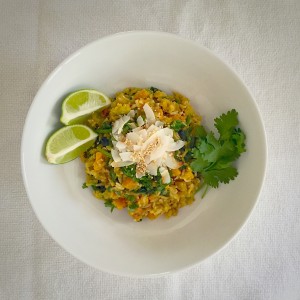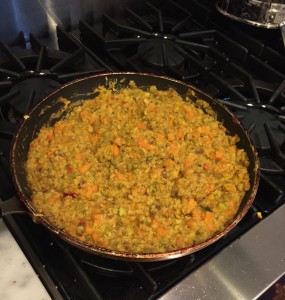The Kitchari Cleanse
by Jill Sockman
Since my September message in news from the blue, I’ve had a lot of interest in the kitchari cleanse. You can certainly find much more information online, but in case that’s all too much, or you would like additional details, here is a little more info. I did about 4.5 days and am still hungry for more.
For a while it will be a staple – maybe not every meal – but on the regular. It’s one of the great things about a cleanse – it resets your palate, energy and cravings, among so many other things!
Some notes:
- A strict kitchari cleanse would be kitchari, very mild/bland or very spicy, depending on the source, at every meal and any snacktime. You may eat as much as often as you like as long as you never feel “full.”
- Absolutes are no dairy, no eggs, no caffeine, no sugar, no meat, no onions or garlic, no nightshades (potatoes, tomatoes, peppers, eggplant, tomatillos, Goji berries and other berries – consult Google-ji for others). Coconut oil or ghee can be used, but no other oils. Often kitchari is a one-pot dish, but I like to make the rice separately, partly for snacks and partly because I make delicious rice. 🙂
- I did a modified cleanse. For breakfast I make oatmeal (it’s a blend w/ millet): almond or soy milk seasoned with powdered ginger, cardamom (a lot) and cinnamon then brought to the boil three times. Then add the oat blend. Drizzle with about one teaspoon of grade B maple syrup.
- You can make one big pot of kitchari and eat from it for no more than three days. I like to make a different one each day for the variety.
- As I need a snack on the regular, I bake sweet potatoes every day. When hungry, heat some ghee or coconut oil in a saucepan, add fragrant rice and some chopped baked sweet potato. Top with sea salt and some shaved coconut (unsweet) that you’ve toasted under the broiler FOR NO MORE THAN 30 SECONDS. Insanely delish and my new favorite snack.
RICE
If making a separate pot:
- Heat coconut oil
- Add cardamom pods, a cinnamon stick, fennel and/or cumin seeds to taste and stir them around until fragrant. Then add the well-rinsed rice and cook per directions.
- Organic white basmati is the classic. I also love Carolina Plantation aromatic rice. Mostly because it is local, and I always think that is good!
KITCHARI
Every day a different combination of:
base
Cumin seeds, brown and/or yellow mustard seeds, ground cumin, ground coriander, ground cardamom, cinnamon, turmeric and fresh ginger (omit if you are pittified).The secret to any good curry, and kitchari is no exception, is the paste. Heat the saucepan and add ghee or coconut oil. Add any seeds first, until they start to sizzle or pop. Then add the rest of the spices and stir constantly until it is super fragrant. Then add the fresh grated ginger. You can also add chili here if you like.
vegetables
Optional. If adding vegetables, add here. Veggies should be diced small to cook very well: carrots, celery, zucchini, sweet potato, kale, chard, spinach. (I don’t like what happens to greens overnight, so I tend to add those toward the end of cook time and eat them all in one sitting, adding more fresh greens and cooking those up when I reheat the dish.
dahl
Next is the legume. The traditional is split mung, which at the Whole Foods can be found in the bulk section as “golden lentils.”
DO NOT use whole mung beans; they are too difficult to digest. You can also try sprouted mung dahl (packaged and across from the bulk). It is very easy to digest and a nice alternative. The amount of water you need to add depends on the dahl you use. In India I’ve had kitchari served thick like a curry, but in an ashram setting it is more soupy. So the water amount is also up to you.
toppings
sea salt, cilantro, fresh lime juice, toasted sesame seeds, toasted coconut
As my friends have many times lamented, I don’t use recipes or measure, so measurements for the base are tough. I like more flavor and depth, so I’ll use 2 tsp – 1T each of the spices except cinnamon/cardamom, which would be more like 1 tsp. It’s something you really can’t add at the end in a meaningful way. Write down what you put in so you can adjust the next time — which I never do, and never have, but it sounds like a good thing to say.
If you cleanse, let me know how it goes. Prepare for the usual cleanse effects, even though it seems like you are eating plenty of deliciousness: headache, GI cleanout, foggy brain, irritability. Especially Day 2. You’ll feel light at the end, I promise.
Shopping List
produce
cilantro
sweet potatoes
carrots
celery
zucchini
greens
ginger
limes
curry leaves
bulk area
cardamom pods, cumin seeds, fennel seeds, mustard seeds, cinnamon stick
ground: turmeric, cardamom, cinnamon, cumin, coriander, ginger
sesame seeds
organic basmati or plantation rice
golden lentils or sprouted mung beans (NOT whole mung beans!)
other
ghee or coconut oil
unsweet shaved coconut
Disclaimer: I’m not an ayurvedic specialist, a nutritionist or a professional chef. Do plenty of research, including talking with your healthcare practitioner, to find out if this is the right thing for you. Most of all, listen to your body, and you’ll start to hear the difference between the cravings of the mind and the cravings of the soul!
All love,
Jill

